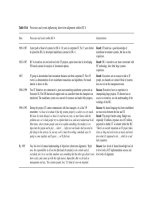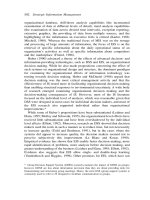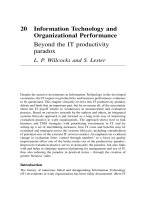Managing information systems 7th edition brow ch09
Bạn đang xem bản rút gọn của tài liệu. Xem và tải ngay bản đầy đủ của tài liệu tại đây (739.79 KB, 57 trang )
MANAGEMENT INFORMATION SYSTEMS
CHAPTER 9
METHODOLOGIES FOR CUSTOM SOFTWARE
DEVELOPMENT
METHODOLOGIES FOR CUSTOM SOFTWARE
DEVELOPMENT
• Large firms purchase software packages whenever feasible, but
development of custom software still highly important
• Custom methodology also used by software companies who
develop products for many different buyers
• Approaches for developing custom applications:
- Traditional Systems Development Life Cycle (SDLC)
- Prototyping
- Rapid Application Development (RAD)
- Agile Development
Copyright © 2011 Pearson Education, Inc. publishing as Prentice
SYSTEMS DEVELOPMENT LIFE CYCLE
• Systems development life cycle (SDLC)
- Highly structured process for developing customized
applications
- Requires a lot of documentation and formal reviews at end of
each major step
- Output from one step = input to next step (Waterfall model)
SDLC Waterfall
Copyright © 2011 Pearson Education, Inc. publishing as Prentice
SYSTEMS DEVELOPMENT LIFE CYCLE
SDLC Waterfall: 8 Steps in 3 phases
Figure 9.1
Copyright © 2011 Pearson Education, Inc. publishing as Prentice
SYSTEMS DEVELOPMENT LIFE CYCLE
Typical SDLC project costs by Steps in 3 Phases
Copyright © 2011 Pearson Education, Inc. publishing as Prentice
SDLC DEFINITION PHASE
Definition Phase
Feasibility Analysis (3 types)
Technical
Operational
Economic
Copyright © 2011 Pearson Education, Inc. publishing as Prentice
SDLC DEFINITION PHASE
Technical Feasibility
• Primary responsibility of the IS analyst
• Based on:
- Knowledge of current and emerging technological
solutions
- IT expertise of in-house personnel
- Anticipated infrastructure needed to both develop and
support the proposed system
Copyright © 2011 Pearson Education, Inc. publishing as Prentice
SDLC DEFINITION PHASE
Operational Feasibility
• Primary responsibility of the business manager
• Entails assessing the degree to which a proposed system
addresses the business issues that gave rise to the idea for
a new information system
Economic Feasibility
•
•
Business managers and IS analysts work together to
prepare a cost/benefit analysis
IS analyst responsible for establishing the
developmental costs for the project
Copyright © 2011 Pearson Education, Inc. publishing as Prentice
SDLC DEFINITION PHASE
Feasibility analysis
• Typical Deliverable:10-20 page document:
- Executive overview and recommendations
- Description of what system would do and how it would operate
- Analysis of costs and benefits
- Development plan
Copyright © 2011 Pearson Education, Inc. publishing as Prentice
SDLC DEFINITION PHASE
Requirements Definition
• Focuses on processes, data flows, and data interrelationships
rather than a specific physical implementation
• Requirements are gathered by:
- Interviewing individuals or work groups
- Reviewing documents
- Observing employees doing their jobs
Copyright © 2011 Pearson Education, Inc. publishing as Prentice
SDLC DEFINITION PHASE
Requirements Definition
• Deliverable = systems requirements document:
- Detailed descriptions of inputs and outputs, processes used to
convert input data to outputs
- Formal diagrams and output layouts
- Revised cost/benefit analysis
- Revised plan for remainder of project
Approved by business managers before next phase begins
Copyright © 2011 Pearson Education, Inc. publishing as Prentice
SDLC CONSTRUCTION PHASE
Construction Phase
• Begins only after the systems requirements document from the
Definition phase is approved
• Three steps:
- System design
- System building
- System testing
Copyright © 2011 Pearson Education, Inc. publishing as Prentice
SDLC CONSTRUCTION PHASE
System Design
• Includes:
- Deciding what hardware and software to use
- Designing structure and content of databases
- Defining programs and their interrelationships
• Critical step for quality system:
Copyright © 2011 Pearson Education, Inc. publishing as Prentice
SDLC CONSTRUCTION PHASE
System Design
• Deliverable: detailed design document
- Models, such as diagrams of system’s physical structure
- Descriptions of databases
- Detailed specification for each program in the system
- Plan for the remaining steps of the Construction phase
Copyright © 2011 Pearson Education, Inc. publishing as Prentice
SDLC CONSTRUCTION PHASE
System Building
• Includes:
- Producing the computer programs
- Developing or enhancing the databases and files to be used by
the system
- Procuring new hardware and support software
• Documentation is a major mechanism of communicating
among members of the project team
Copyright © 2011 Pearson Education, Inc. publishing as Prentice
SDLC CONSTRUCTION PHASE
System Testing – by IS specialists
• Time-intensive step (if executed well)
- Each module of code is tested
- Modules are assembled into subsystems and tested
- Subsystems are combined and entire system is integration tested
Copyright © 2011 Pearson Education, Inc. publishing as Prentice
SDLC CONSTRUCTION PHASE
System Testing – by Users
User Acceptance Testing: Ensures that the system performs
reliably and does what it is supposed to do in the user environment
Who might participate in User Testing?
Copyright © 2011 Pearson Education, Inc. publishing as Prentice
SDLC IMPLEMENTATION PHASE
Implementation Phase
• Success of this phase is highly dependent upon business
manager involvement
- Installation
- Operations
- Maintenance
Copyright © 2011 Pearson Education, Inc. publishing as Prentice
SDLC IMPLEMENTATION PHASE
Installation
• Includes:
- Building files and databases
- Converting relevant data from one or more old systems to the
new system
- Training system users
Installations that involve converting data from an old system to a
new one can be as difficult to implement as systems to automate
totally new functions or processes
Copyright © 2011 Pearson Education, Inc. publishing as Prentice
SDLC IMPLEMENTATION PHASE
Installation
Four Approaches to Convert from an old System:
• Parallel: organization operates old system in parallel with new
system until new system is working sufficiently
• Pilot: new system is introduced to only one part of the
organization first
• Phased: new system is implemented one component at a
time
• Cutover: old system is totally abandoned as soon as the
new system is implemented
Copyright © 2011 Pearson Education, Inc. publishing as Prentice
Fig 9.4
SDLC IMPLEMENTATION PHASE
Operations
• New application that is operational is referred to as in
“production mode”
• Project team is disbanded at this time or shortly thereafter
• Requires two types of documentation
- System documentation for IS specialists who operate and
maintain the system
- User documentation for those who use the system
Copyright © 2011 Pearson Education, Inc. publishing as Prentice
SDLC IMPLEMENTATION PHASE
Maintenance
• The process of making changes to a system after it has been
put into “production mode”
• Reasons for maintenance
• Correct errors in the system
• Adapt the system to changes in the business environment
• Enhance or improve the system beyond the original system
requirements
Copyright © 2011 Pearson Education, Inc. publishing as Prentice
SDLC IMPLEMENTATION PHASE
Maintenance
• In the past, maintenance step has incurred about 80% of total
costs over a system’s life
• In the 1990s, systems development resources heavily devoted
to system maintenance versus new system development:
- 75% to run and maintain existing systems
- 35% to build/buy new systems
Copyright © 2011 Pearson Education, Inc. publishing as Prentice
SDLC IMPLEMENTATION PHASE
Maintenance
• Common Problems:
- Documentation may not be updated when changes to the
system are made, causing problems for future maintenance
- Changes to one part of the system may have an
unanticipated effect on other parts of the system (i.e., a
ripple effect )
- Programmers generally prefer new development, not
maintenance, so work may go to least experienced
programmers
Copyright © 2011 Pearson Education, Inc. publishing as Prentice
SDLC IMPLEMENTATION PHASE
Maintenance
Business managers need to be aware that:
- Maintenance can introduce new errors into the system
- If IT resources not available, there may be long delays before
a requested system change is worked on, creating gaps in
system performance and the needs of an organization
Copyright © 2011 Pearson Education, Inc. publishing as Prentice









